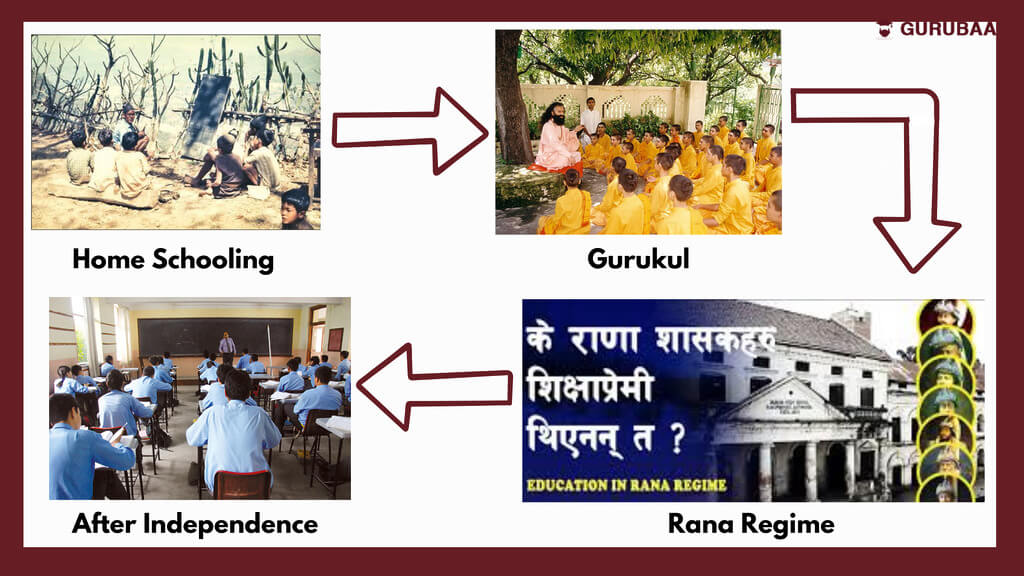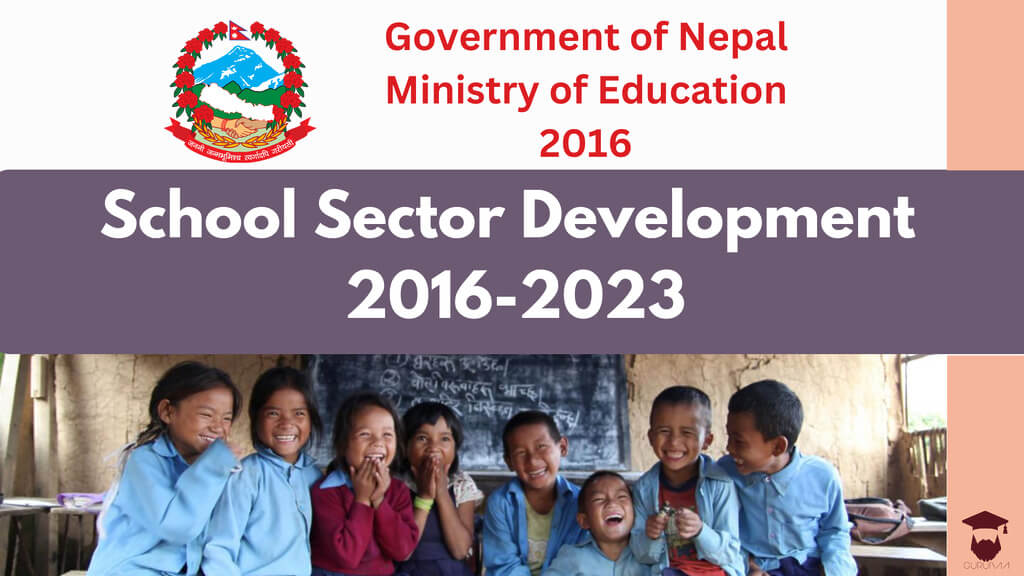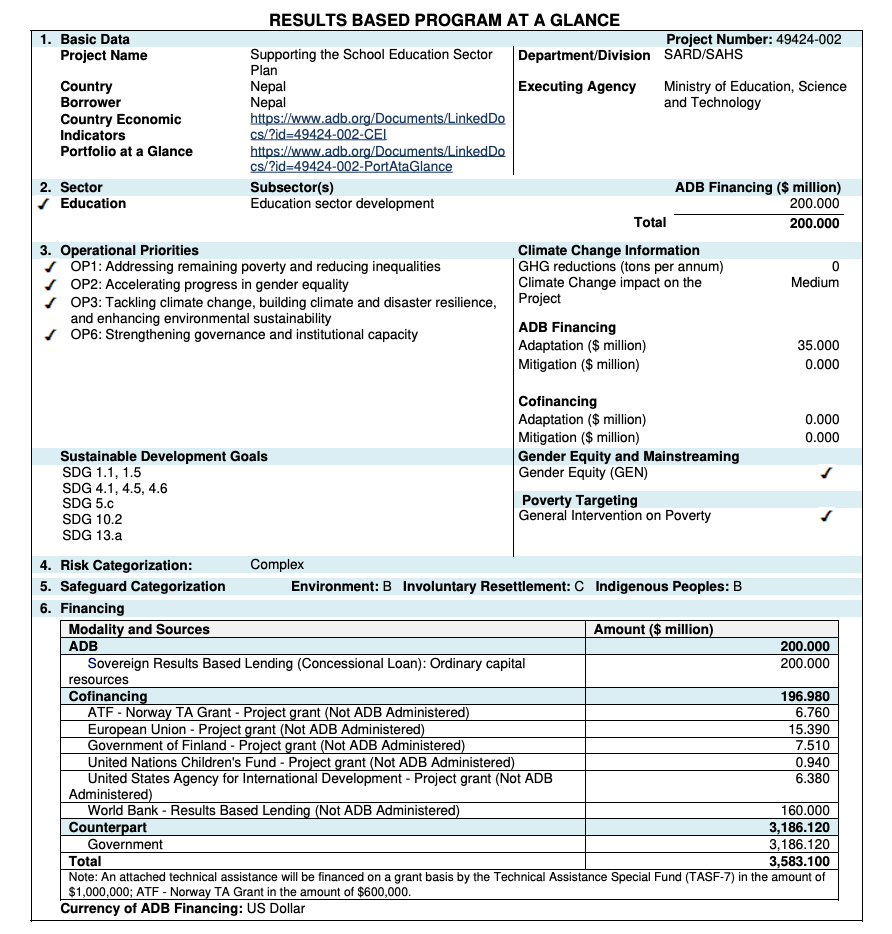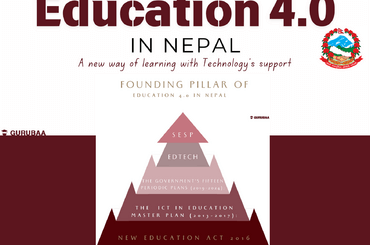Brief History of Education
The education system of Nepal has a long, interesting, and unique history. Before the democracy, Nepal was governed by the Kings, Ranas, and even the Panchayat system, but in all cases, there was a hierarchy in the provision of education. Talking about the first way of schooling in Nepal, as per the records, education was portrayed through homeschooling and Gurukuls. During homeschooling, academic sessions were conducted at home by family members or the local priests and among the higher caste citizens and the ones who could afford it, and basic literacy, religious academics, and daily-life essentials were taught. After that, the concept of Gurukul came in, where the students had to leave their houses and stay in a particular area to take classes from the gurus (teachers). To understand this better, we can imagine this as the present boarding school. Furthermore, the curriculum in Gurukul included religious philosophy and Buddhism, such as Vedas and Upanishads for Brahmins, and administration and military for Chhetris. Meanwhile, lower cast and poor people were forbidden to take the academics.

After that came the Rana Era when many schools and institutions were formed, but education was only limited to Ranas. Initially, when Jung Bahadur Rana returned from a visit to England in 1850, he recognized the need for structured education in Nepal and established a formal school in Nepal, named Durbar High School in 1854. Also, Ranas were allowed to take foreign education by going to foreign lands. Nevertheless, with the introduction of democracy and with the end of the Rana Regime, Normal people were allowed to officially study in academic institutions and the first ever University was established in 1959, Tribhuvan University, just 8 years after the end of the Rana Regime. After that, continuous progress and implementations have been made, to date, to enhance the academic system of the country.
Rounding around the academic situation of Nepal during the establishment of Tribhuvan University, there was only one college providing higher education in Nepal, and that was Trichandra College. The college was affiliated with two different universities in India (University of Calcutta, and Patna) distinctly. After the establishment of TU, Trichandra College was affiliated to it.
With time, various colleges and universities were established to enhance the academics of Nepal. Students willing to study abroad started getting permission and NOC. Those willing to study in Nepal but with a foreign degree were also provided with a foreign degree. In just 73 years of education being delivered to the public, the academic scenario has changed vastly as people started understanding the importance of education.
Current Academic Condition in Nepal
Although Nepal has made great progress when it comes to the course contents, the number of colleges, schools, and the overall curriculum, more and more Nepali students are leaving the country to seek better education quality. This ultimately adds on to the factor that there is no proper education system in the country, although the curriculum seems to be brilliant. The report published by the Asian Development Bank in its ‘Proposed Results-Based Loan and Technical Assistance Grant Nepal: Supporting the School Education Sector Plan (2022), mentions that 79.1% of the laborers, either working or searching for work, do not even have secondary education qualification, acting as a productivity barrier for the country. The overall academic provision has not been able to meet the international market’s needs fully. What education systems here refer to are all the opportunities, proper teachers, extracurricular activities, practical sessions, punctuality, and all other factors associated with education to build a proper study environment. Hence, seeking such facilities and opportunities, students choose to study abroad rather than continue their studies in Nepal.
SSDP: One of the Successful Academic Projects in Nepal

However, various approaches have been made to ensure that the academics in Nepal become more systematic. For doing so, various international bodies and programs have been continuously supporting Nepal. For instance, to improve the efficiency and effectiveness of Nepal’s school system, the World Bank supported the School Sector Development Program (SSDP). This program was targeted at girls, vulnerable children, and disadvantaged groups to increase their grades, make them stay in school, provide targeted scholarships, and enhance the assessment systems. With such advantages received, the number of out-of-school children declined by 6.76%.
The SSDP was financially supported by the Bank’s Program for Result (PforR), and other 9 joint financing partners (JFP) including Finland, Japan, Norway, the International Cooperation Agency, the European Union, and the Asian Development Bank.
Moreover, with the same 7-year-long program (2016 to 2023), various positive changes were seen in Nepal;
| S.no | Basis | 2016 | 2023 | (Targeted) | Increased by |
| 1 | Survival Rate up to grade 12 | 11.50% | 33.10% | 25% | 21.60% |
| 2 | Reduction of out-of-school children | 6.76% | 5.60% | – | -1.16% |
| 3 | Net Enrollment Rate (NER) of basic education in 15 most disadvantaged districts for boys | 85.10% | 92.20% | 91.40% | 7.10% |
| 4 | NER for Girls | 83.60% | 90.90% | 90% | 7.30% |
Besides these, as per the audit report, 99% of the total fund was used for the actual work, and utilized as per the guidance assigned. With such positive results and proper utilization of funds, nearly 8.2 million students benefitted, among which 4.07 million were girls.
What Conclusion can be Made out of This?
Being inspired by this project, it can be seen that, if the funding is properly utilized to strategically run a project, then the target can be easily achieved or even exceeded. Another reason that influenced the success of this project could be that people in Nepal have understood the importance of education, not only at the individual level but for the entire country.
Ongoing Projects
The SSDP program mentioned above is a successfully completed project that enhanced qualitative equality in rural areas ensuring that there were more school students in every region. The Project’s plan was designed based on Nepal’s new federal model, and hence, is relevant to the teaching and learning practices of national education. With the grand success of SSDP, the MoEST (Ministry of Education, Science, and Technology) has formed partnerships with local-level governments and Provinces to ensure that its upcoming inclusive education-related initiatives are favorable for improving the quality of education as well as the overall education policies. Some of the upcoming, and ongoing projects and plans initiated by the MoEST under the supervision of the Government of Nepal, for improvising the educational policy are listed below.
Nepal School Education Sector Plan (SESP) (2021-2030)
The SSDP was a successful 7-year plan for which, initially, the first five years was only planned (2016-2021) initially, of the overall 7-year plan. Continuing this project as well as the School Sector Reform Plan (SSRP), the SESP was started in 2021, with the support of Finland. In fact, Finland has become a part of Nepal as a least developed country for bilateral development cooperation, and out of the three main cooperation sectors that Finland and Nepal have, teaching is one of them. The program will be further working on ensuring that there will be more students in the school, alongside proper quality of education and improvised management in the overall development program. The 9-year-long program was created with the motive to benefit students from pre-school to high school (grade 12).
For this project, most of the funding is done by Nepal (about 90%), while the remaining 10% is from the donors. For this, Finland will be funding a maximum of 19 million euros for a 4 year long time period (2022 to 2026).
Financing Sources for the Project
Supporting the School Education Sector Plan
This is a plan that was created when the SESP Project was also running (2022-2026). Let’s look into the overall program through this image;

All the investors from foreign land as well as from Nepal decided to follow the ‘Result-based loan provision’ for supporting the School Education Sector Plan. This plan was implemented to ensure that there is even better result from SESP than it was from SSDP. SSDP was a successful project, and one of the main reasons for its success was the RBL (Result-Based Lending). With such programs, and supporting plan to enhance those programs the government is positive that Nepal can meet its long-term vision as well as its commitment to Sustainable Development Goals, soon.

Efforts made by the Government on a regular basis
In recent decades, more and more children are going to school, which could result in a proper shaping of the future of Nepal. With government at both local and national levels, along with the general public’s enhanced understanding regarding the importance of education, the investment made in education purpose seems to be utilized effectively. The government along with the support of national and international programs has been able to increase access to education by increasing the number of community schools, Also, with a provision like free education up to grade 10, and at least 1 free nutritious lunch for students up to class 5.
Along with this, another factor in attracting students is the introduction of a new and required curriculum that has emphasized required critical thinking skills, proper training for the teachers, and specific standards pre-set to ensure that quality education is delivered. Along with this, proper technology and innovative strategies are also maintained. Along with preparing students for degree-level academics, the government has been equally supporting skills development learning by promoting vocational training education for free.
The Government of Nepal Reveals Its Plan
Furthermore, a certain number of seats are separated for disabled, Dalits, or backward people as such people are scared to come out and fight with the prioritized ones. And, there is also a possibility that normal people would easily win a slot against backward people. Now, bringing more and more students to the school would be of no use, if there are not enough teachers. Hence, to solve this problem, the government started reviewing the teacher-student ratio in community schools, ensuring that there are enough teachers, and there is no shortage of major subject teachers like Maths, Science, English, and, Techincal ones.
Furthermore, to enhance the use of technology in governmental schools, the government has also reduced the internet connection fee by 50%. Moving towards technology and trends, the government has further worked on creating a curriculum based on the modern-day education system. For this, the government has made legal arrangements and has been working on changing and enhancing the curriculum system based on technological advancement and modern-day requirements.
In order to analyze whether the higher education providing universities have properly met the standards set by the government, the government is planning to engage with the universities, research public concerns through the universities, and label them in terms of the quality of education, further rewarding them with a certain amount of grants. Nevertheless, the government is also planning to bring international students back, by luring them with proper scholarship and employment opportunities.
Initiatives taken by Local Level Government
In Nepal, 11% of the total budget is separated for education, and it has not been enough to cover every aspect including free education, free food campaigns at the school level, and qualitative education. The involved Stakeholders are demanding at least 20% of the overall budget done. Limitations like the availability of teachers, infrastructure limitations, and various other factors have been the barrier to education. Furthermore, almost 80% of the funds go for administrative and operational expenses, leaving only 20% in direct education. Dr, Bal Chandra Luitel, an educationist in Nepal, suggested that 11% of the allocated, the budget rate could be sufficient to cover the education needs if managed efficiently, and transparently.
Interactive Panel Board at Ilam
However, strategically implementing the same budget for multiple purposes could be a solution to this problem, and the local government of Suryadaya Municipality in Ilam has proven this statement and idea of strategic use of budget for adequate pedagogy. They invented a tool called Interactive Panel Board and allowed students from different schools to join the panel when the teachers from Phikkal Secondary School and Jyoti Secondary School provided live classes of Science and Maths.
Although this is not something new and falls under online education, this idea can be termed as a strategic approach to enhance education remove the geographical barrier, and eradicate problems like the absence of teachers. Adding on to this scenario, one of the educationists of Nepal, Dr Pramod Bhatta mentioned that decentralization of education could be an effective way of properly utilizing the educational budget. He further mentioned that local governments know the situation of their locality more than the federal government, and hence they should be working on monitoring and overseeing the educational system of their locality.
Sikai Project at Sarlahi
This project is a 6-year long project (2018-2024), started with an aim to increase the number of students by providing them with access to education and help them achieve equitable learning outcomes when it comes to basic education. To be more specific, the project aims to ensure that more students pass their grade 5 examination. Supporting the initiative of the government, the district felt that students there were not equally benefited from all the opportunities and hence started the project ‘Sikai’. The project is funded by Australian NGO Cooperation Program (ANCP), and further implemented by Rastriya Rojgar Prawardhan Kendra (RRPK), World Vision International Nepal, and Handicap International. Along with ensuring that students surpass different levels during their academic year, this project also aims to improve participation and engagement of excluded groups of people in terms of caste, gender, ethnicity, and gender and has a total budget of USD 5,347,717 to cover four municipalities under Sarlahi District including 58 community schools, and 23 Madrasas.
Suggestions Made by Experts, and Educationalists for a Better Future of Education in Nepal
- Dr, Baburam Adhikari, an educationalist, suggested that just like the Suryadaya Municipality, other localities should also work on developing their own innovative models that fit the funding as well as the academic needs. Copying from any other international practices could seem cool but it might not fit the needs, resources, and budget of the local municipalities.
- Dr, Bal Chandra Luitel, another educationalist, suggested working on public financing by utilizing resources available, utilizing technological tools, and managing the budget transparently.
- Dr. Pramod Bhatta, also an educationalist, suggested that giving the right to utilize of the budgets to the local government could add to proper and strategic utilization of budgeting. He appreciated the existing ‘Ghumti Teachers’ policy and mentioned how it could eradicate the problem of teacher shortage in remote areas. Further, he proposed a ‘Padhdai Kamaudai’ program where students are provided with an opportunity to earn enough to at least cover their school fees. He recommended this program after realizing the risk of dropping out rate.
These are some of the suggestions delivered by the experts of Nepal, after individually seeing, going through, and dealing with the academic condition of the country.

